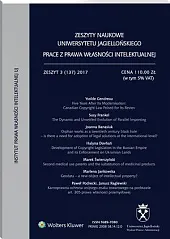Ysolde Gendreau
Pięć lat po nowelizacji kanadyjskie prawo autorskie gotowe do przeglądu
str. 5
Susy Frankel
Dynamiczna i chaotyczna ewolucja importu równoległego
str. 24
Joanna Banasiuk
Ysolde Gendreau
Pięć lat po nowelizacji kanadyjskie prawo autorskie gotowe do przeglądu
str. 5
Susy Frankel
Dynamiczna i chaotyczna ewolucja importu równoległego
str. 24
Joanna Banasiuk
str. 37
Halyna Dovhań
str. 49
Marek Świerczyński
str. 64
Marlena Jankowska
str. 76
Paweł Podrecki, Janusz Raglewski
str. 98
Joanna Banasiuk
Orphan Works as a Twentieth Century Black Hole Is There a Need for the Adoption of Legal Solutions at International Level?
Despite the fact that the orphan works problem is an international issue, neither the European Union nor the United States have been trying to fi nd a legal compromise in order to implement a minimal legal provision common for both Europe and the U.S. The intangible and cross-border nature of the works and the fact that they may be exploited in many places simultaneously, given the global nature of the Internet, raise some doubts as to whether regional solutions may provide effi cient protection of particular interests in the information technology era. Therefore, an international solution would be justifi ed due to numerous circumstances. However, it is to be noted that countries have already made investments in crafting their own solutions. In these circumstances, an international discussion on the copyright paradigms seems to be more and more necessary.
Początek strony
Halyna Dovhań
The Development of Copyright Legislation in the Russian Empire and its Enforcement on Ukrainian Lands
Ukrainian lands had been divided among other states for a long period of time. As a result, foreign legislation was valid within these lands infl uencing the formation of law enforcement practice, legal culture and legal awareness a lot. In order to understand the current processes in this specifi c sphere it is worth looking at the previous experience. This may facilitate the interpretation of many of todays problems.
Początek strony
Marek Świerczyński
Second Medical Use Patents and the Substitution of Medicinal Products
This paper relates to the legal problems of second medical use patents and the substitution of medicinal products. It is inspired by two recent rulings of the English and Dutch courts. These courts have considered whether the sale of generic drugs may be regarded as an infringement of a second medical use patent in case where the facts of the case showed that these drugs have actually been used as in the indications covered by this patent (i.e. off-label use). The author of this paper wishes to give an answer to the following question whether it is appropriate to limit the scope of the second medical use patent, where medicinal products based on the substance are subject to public reimbursement, in order to provide wider access to these products.
Początek strony
Marlena Jankowska
Geodata A New Object of Intellectual Property?
It should be pointed out that there has recently been a constantly high level of interest in technical sciences, partly driven by the daily public need for geo-information (GI) and by the mere availability of so many geographically relevant applications. It should be emphasised that, though the extensive geoinformation literature in the area of technical sciences takes many positions and though their references to IPR are ever-increasing, the IPR issues related to GI are expressed in clumsy and very general terms, accepting entirely as dogma and as shibboleth beyond any doubt that digital maps (along with digital geodata2) fall under copyright protection. This appears to be only a manifestation of a much greater problem, that of copyright protection for data as such, which is just now becoming an issue of common interest to both academics and European lawmakers.
Początek strony
Paweł Podrecki, Janusz Raglewski
Karnoprawna ochrona unijnego znaku towarowego na podstawie art. 305 prawa własności przemysłowej
Spośród przepisów karnych ustawy z 30.06.2000 r. Prawo własności przemysłowej największe znaczenie w praktyce ma art. 305 p.w.p. Penalizuje on czyny związane ze zjawiskiem tzw. piractwa w dziedzinie znaków towarowych. Warunkiem sine qua non prawidłowej realizacji swojej funkcji przez znak towarowy jest zapewnienie należytej ochrony wyłączności używania takiego oznaczenia przez uprawniony do tego podmiot. Oczywiste jest, że wraz ze wzrostem znaczenia takich oznaczeń w obrocie powinna również zostać wzmocniona ich ochrona, w tym przy wykorzystaniu instrumentów prawa karnego. Temu właśnie celowi służy regulacja zawarta w art. 305 p.w.p. Zgodnie z ust. 1 powołanego artykułu, Kto, w celu wprowadzenia do obrotu, oznacza towary podrobionym znakiem towarowym, zarejestrowanym znakiem towarowym, którego nie ma prawa używać lub dokonuje obrotu towarami oznaczonymi takimi znakami, podlega grzywnie, karze ograniczenia wolności albo pozbawienia wolności do lat 2. W pozostałych dwóch przepisach art. 305 p.w.p. przewidziany jest wypadek mniejszej wagi (ust. 2) oraz kwalifi kowany typ czynu przestępnego, w którym okolicznością uzasadniającą surowszą odpowiedzialność karną (zagrożenie karą pozbawienia wolności od 6 miesięcy do lat 5) jest uczynienie sobie przez sprawcę z popełnienia przestępstwa określonego w ust. 1 prezentowanego artykułu stałego źródła dochodu albo dopuszczenie się tego czynu przestępnego w stosunku do towaru o znacznej wartości. Konstrukcja jurydyczna przestępstw określonych w art. 305 p.w.p. nie jest wolna od problemów wykładniczych. W ramach niniejszych uwag chcielibyśmy skoncentrować się na jednym z nich. Chodzi o rozstrzygnięcie kwestii, czy karnoprawna ochrona gwarantowana tym artykułem obejmuje także unijny znak towarowy (wcześniej wspólnotowy znak towarowy).
Początek strony






